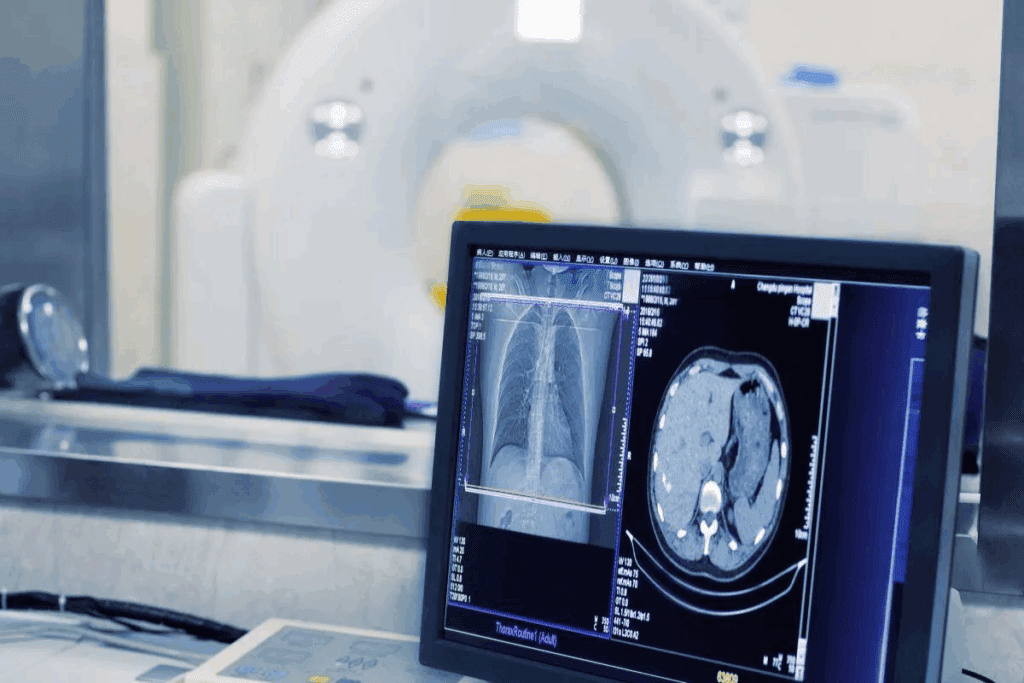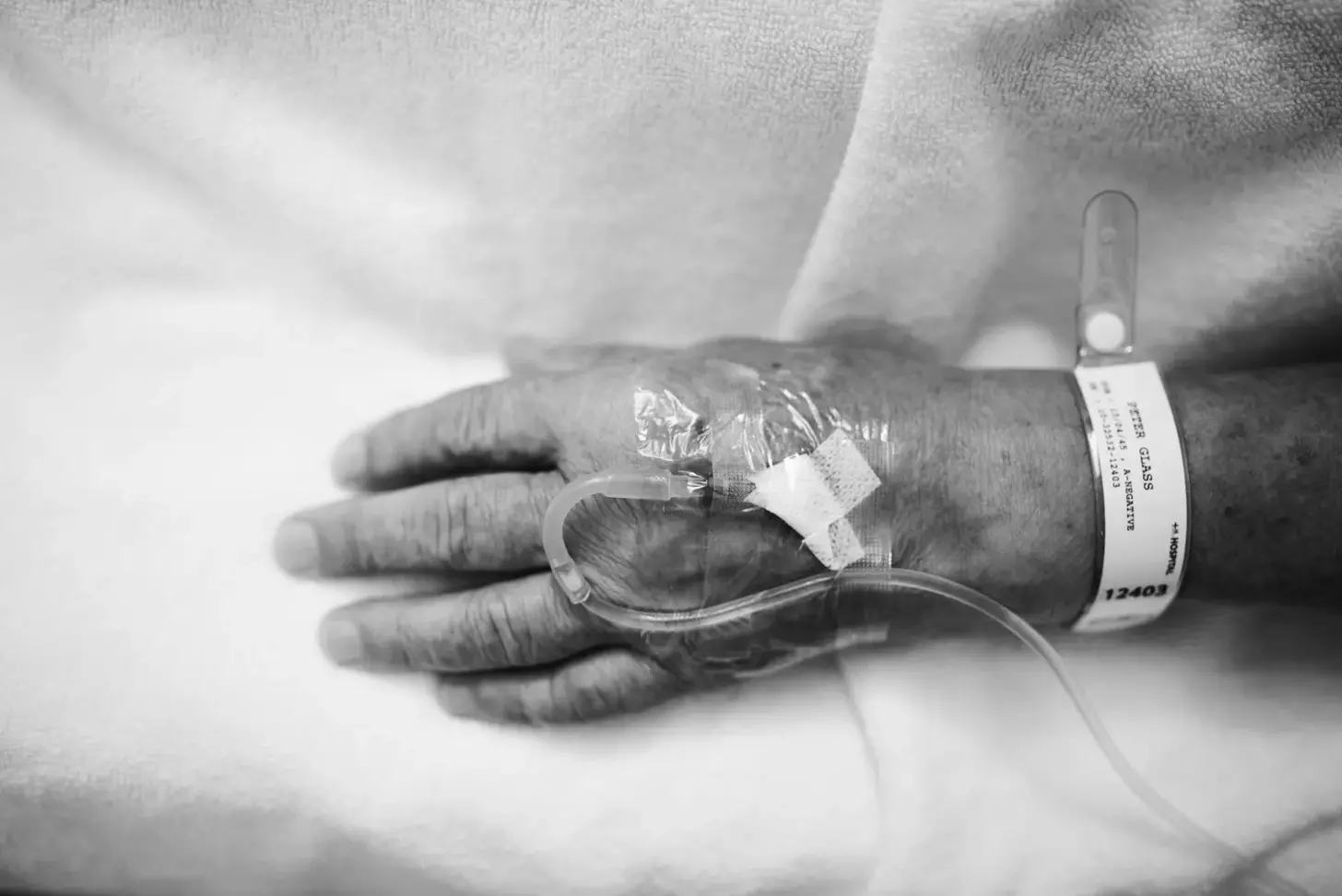Last Updated on November 26, 2025 by Bilal Hasdemir

We aim to provide top-notch healthcare to everyone, including international patients. At Liv Hospital, we use the latest medical methods to keep patients safe and get the best results. One key method is the IR guided biopsy. It’s a small procedure that uses images to take tissue samples for tests.
Interventional radiology (IR) is a field that uses images to find and treat diseases without big cuts. With image-guided biopsy, we can quickly and accurately diagnose. This shows our dedication to trust, new ideas, and working together as a team.
Key Takeaways
- IR guided biopsy is a minimally invasive diagnostic procedure.
- It uses imaging technologies to sample tissue accurately.
- This technique is part of interventional radiology, a specialty that diagnoses and treats diseases with minimal invasion.
- Liv Hospital employs advanced image-guided procedures for rapid and reliable diagnoses.
- Our commitment to patient safety and optimal outcomes is key.
The Fundamentals of Medical Biopsies

Medical biopsies have come a long way. They are now more precise and less invasive. These procedures are key in diagnosing and treating many health issues.
Purpose of Diagnostic Biopsies
Diagnostic biopsies help doctors understand diseases. They collect tissue or cells for examination. This helps in creating the right treatment plan.
Biopsies are mainly used for cancer diagnosis. But they also help in diagnosing infections and inflammatory diseases.
Evolution of Biopsy Techniques
Biopsy methods have changed a lot over time. From old surgical biopsies to new, less invasive ways. Today, imaging like ultrasound and CT scans guide the biopsy needle. This makes the procedure safer and more accurate.
| Technique | Description | Advantages |
| Surgical Biopsy | Involves surgically removing a sample of tissue. | Provides a large tissue sample for examination. |
| Needle Biopsy | Uses a needle to collect a tissue or cell sample. | Less invasive, quicker recovery. |
| Image-Guided Biopsy | Utilizes imaging technologies to guide the biopsy needle. | High precision, reduced risk of complications. |
What Is an IR Guided Biopsy and How Does It Work?

Interventional radiology (IR) guided biopsy is a big step forward in medical diagnosis. We use tools like ultrasound, CT, MRI, or fluoroscopy to guide a needle into the body. This lets us get tissue samples from hard-to-reach places with great precision.
Definition and Core Principles
An IR guided biopsy is a small, non-invasive way to get tissue samples for tests. It relies on advanced imaging to see the target area in real-time. This ensures the needle is placed exactly right.
The steps include:
- Planning before the procedure using images to find the target area.
- Using real-time images to guide the needle during the biopsy.
- Getting tissue samples for lab tests.
Precision and minimal invasiveness are key to IR guided biopsy. It’s a good choice for patients needing tissue samples.
Historical Development
The growth of IR guided biopsy is linked to better imaging and interventional radiology. Over time, biopsies have become more accurate and safe.
The history of IR guided biopsy is tied to imaging advancements. Ultrasound, CT, MRI, and fluoroscopy have made it easier to see inside the body. This has led to more precise biopsy methods.
The integration of these technologies has changed how we diagnose and treat diseases. It has made our work more effective.
Imaging Technologies Used in IR Guided Biopsy
IR guided biopsies get a big boost from advanced imaging. The right imaging tech depends on the lesion’s location and type, the patient, and the procedure’s needs.
Ultrasound Guidance
Ultrasound is a top choice for IR guided biopsies. It’s great for lesions in the liver, kidney, and thyroid because it offers real-time images without radiation. Plus, it’s easy to move around.
CT Scan Guidance
CT scans are key for precise imaging. They’re perfect for hard-to-see lesions or deep ones. CT scan guidance gives clear images, helping place the needle accurately.
MRI Guidance
MRI is top-notch for soft tissue imaging. It’s ideal for soft tissue tumors and lesions in the breast or prostate. MRI guidance helps target lesions safely.
Fluoroscopy Guidance
Fluoroscopy uses X-rays for live images. It’s great for lung biopsies and vascular procedures. Fluoroscopy shows the needle’s path in real-time.
In summary, picking the right imaging tech is key for IR guided biopsies. It depends on the lesion, its location, and the patient. The right choice makes the procedure more accurate and safe.
Medical Conditions Diagnosed Through IR Guided Biopsy
We use IR guided biopsy to find many medical conditions. It helps patients get the right diagnosis and treatment. This method is key for getting tissue samples to spot diseases.
Cancer Diagnosis
IR guided biopsy is key for cancer diagnosis. It takes tissue samples from areas that might have cancer. This helps doctors know if there’s cancer and what kind it is.
IR guided biopsy is precise. It lowers the chance of problems and makes diagnosis more accurate.
For cancer diagnosis, advanced imaging guides the needle to the tumor. This makes sure the sample is from the right place. It helps in planning the best treatment.
Liver and Kidney Disease Assessment
IR guided biopsy is also great for checking liver and kidney diseases. It can show how much damage there is in the liver. It helps decide on treatment for liver issues like cirrhosis or hepatitis.
For kidney diseases, it can find out why the kidneys aren’t working right. This could be due to things like glomerulonephritis or transplant rejection.
The precision of IR guided biopsy is a big plus. It lets doctors take targeted samples. This lowers the chance of mistakes and boosts confidence in the diagnosis.
Infection Identification
IR guided biopsy can also find infections when it’s not clear what’s causing them. It takes tissue or fluid samples. Doctors can then find the cause of the infection and choose the right antibiotics.
This is very important for infections like abscesses or infected tumors. Precise sampling leads to better treatment and outcomes for patients.
Patient Selection for IR Guided Biopsy
The success of an IR guided biopsy depends a lot on choosing the right patients. It’s key to pick the right candidates for this procedure to make it work well.
Ideal Candidates
People who need tissue samples but can’t have surgery are perfect for IR guided biopsy. This method is less invasive and helps them recover faster. Those with hard-to-reach lesions or tumors are great candidates.
Also, those at high risk for surgery problems can benefit from this biopsy. This includes people with serious health issues or those on blood thinners.
Contraindications
Even though IR guided biopsy is safe, there are some who shouldn’t have it. People with severe bleeding problems or who can’t stay calm during it might not be good candidates. Those allergic to contrast agents used in imaging also need careful consideration.
It’s important to check a patient’s health and any risks of the procedure. A doctor’s thorough check is needed to see if IR guided biopsy is right.
By picking the right patients and knowing who shouldn’t have it, doctors can make sure the biopsy is safe and works well. This leads to accurate diagnoses and the right treatment plans.
The Complete IR Guided Biopsy Procedure
Learning about the IR guided biopsy procedure can ease worries and get patients ready. It covers several steps, from getting ready to the biopsy itself, and then aftercare.
Pre-Procedure Preparation
Before the biopsy, patients go through some steps. They might stop certain meds, fast, and get a ride home. Our team gives clear instructions to help prepare them well.
During the Procedure
During the biopsy, the patient lies on an imaging table. The area is cleaned and ready. Local anesthesia is used to reduce pain.
The radiologist uses imaging to guide the needle. They collect tissue samples carefully. The whole thing is watched closely for safety and accuracy.
Types of Tissue Samples Collected
The type of tissue sample depends on the suspected issue and where it is. Samples can be fine-needle aspirates, core needle biopsies, or vacuum-assisted biopsies. Each has its own use and benefits, chosen based on the situation.
After, the samples go to a lab for analysis. The lab report is key for diagnosis and treatment plans.
Patient Experience and Comfort During an IR Guided Biopsy
Ensuring patient comfort is a top priority during an IR guided biopsy. Medical teams take all necessary steps to make sure patients are safe and comfortable. We know that getting a biopsy can be scary for many.
Anesthesia Options
To reduce discomfort, several anesthesia options are available. Local anesthesia is often used to numb the area where the needle is inserted. Sometimes, conscious sedation is given to help patients relax.
Conscious sedation keeps patients lightly asleep but awake enough to respond to commands or touch.
What Patients Can Expect
Patients are placed on an imaging table for the biopsy. The area is cleaned and sterilized. Local anesthesia is given to numb the skin and tissues.
The biopsy needle is then guided to the right spot using imaging like ultrasound or CT scan. Patients might feel some pressure or discomfort, but it’s usually mild. Our team works hard to keep patients comfortable.
After the biopsy, patients are watched for a bit to check for any issues. Most can go back to their usual activities in a day or two.
Key aspects of patient comfort during IR guided biopsy include:
- Effective communication with the medical team
- Anesthesia options tailored to the patient’s needs
- Continuous monitoring during the procedure
- Post-procedure care instructions
We focus on making the IR guided biopsy experience as comfortable and stress-free as possible.
Advantages of IR Guided Biopsy Compared to Surgical Biopsy
IR guided biopsy has changed the game in diagnostics. It offers many benefits over traditional surgical biopsy. This new tech is a big step forward in medical care and getting accurate diagnoses.
Minimally Invasive Benefits
IR guided biopsy is minimally invasive. It doesn’t need big cuts like surgical biopsies do. Instead, it uses small needles guided by images.
This means patients feel less pain and face lower risks of problems. They also recover faster because of less damage.
Precision and Accuracy Improvements
IR guided biopsy is also more precise and accurate. It uses advanced imaging like ultrasound or MRI for real-time guidance. This makes sure the needle hits the right spot.
This precision is key when dealing with small or hard-to-reach tissues. It leads to more reliable results.
Safety Profile
The safety of IR guided biopsy is a big plus. It’s less likely to cause infections or bleeding. This is because it’s less invasive than surgery.
Also, IR guided biopsy can be done as an outpatient procedure. This means patients don’t have to stay in the hospital. It’s safer and more efficient for everyone.
Recovery and Aftercare Following an IR Guided Biopsy
Recovery and aftercare after an IR guided biopsy are key for healing. After the biopsy, it’s important to follow the recovery steps carefully. This helps avoid complications and ensures a smooth healing process.
Immediate Post-Procedure Monitoring
Right after the procedure, patients are watched closely. This is to catch any immediate problems. Our team is ready to help if anything goes wrong, keeping the patient safe.
At-Home Care Instructions
Patients get detailed care instructions for at-home use. This includes how to look after the biopsy site and what to watch for. Following these steps is vital for healing and avoiding complications.
When to Seek Medical Attention
Knowing when to get medical help is important. We give clear signs of when to call a doctor. This includes severe pain, too much bleeding, or infection signs. If these happen, patients should reach out to their healthcare provider right away.
From Sample to Diagnosis: Analysis of Biopsy Specimens
After getting the biopsy sample, it goes through a detailed check to find out what’s wrong. This step is key to figuring out if a disease is present, what’s causing it, or how far it has spread.
Pathological Examination Process
Pathologists, experts in disease diagnosis, look at the biopsy samples. They are vital in the diagnosis process, using different methods to study the samples.
To prepare the biopsy for a microscope, it’s fixed, stained, and cut into thin slices. This makes it ready for detailed study.
Advanced Testing Methods
Modern tests are also used to check the biopsy samples. These include molecular tests like PCR and FISH. They help spot specific genetic issues.
Other advanced tools like immunohistochemistry and imaging help give more detailed info. This helps in making a more precise diagnosis.
Timeframe for Results
How long it takes to get the results depends on the tests needed and the tissue type. Usually, results are ready in a few days to a week.
Sometimes, more time is needed for complex tests. Patients are told how long it might take by their doctors.
Cost and Insurance Considerations for IR Guided Biopsy
It’s important for patients to know about the costs of medical procedures like IR guided biopsy. The price can change a lot based on where it’s done, who does it, and your insurance.
Typical Procedure Costs
The price for an IR guided biopsy can vary a lot. It can be a few thousand dollars or more than ten thousand dollars. Things that affect the cost include how complex the procedure is, the imaging technology used, and the facility’s fees. For example, MRI-guided procedures are usually pricier than those using ultrasound.
There might also be extra costs for before and after the procedure, and for analyzing the biopsy samples. It’s a good idea to talk to your doctor about these extra costs. This way, you’ll know the total cost.
Insurance Coverage
Insurance coverage for IR guided biopsy can vary a lot. Many plans cover it when it’s needed for medical reasons, but how much they cover can differ. It’s best to check with your insurance to see what’s covered and what you might have to pay for yourself.
Before getting the biopsy, you might need to get approval from your insurance. Your doctor can help you with this. They’ll make sure you have all the right paperwork for your insurance.
Questions to Ask Your Provider
To understand the costs of IR guided biopsy, ask your doctor some important questions:
- What is the total cost of the procedure, including any extra fees?
- How much of the cost will my insurance cover?
- Are there any costs I’ll have to pay for myself?
- Are there any extra costs for follow-up care or if there are complications?
Knowing about the costs and insurance for IR guided biopsy helps patients plan better. It makes them more ready for this important test.
Conclusion: The Future of IR Guided Biopsy in Precision Medicine
IR guided biopsy has changed how we diagnose diseases. It’s a precise and gentle way to get tissue samples. This method is becoming more common as imaging and biopsy techniques get better.
The future of IR guided biopsy is bright. Scientists are working hard to make it even more accurate and effective. This will help doctors create treatment plans that fit each patient’s needs perfectly.
As precision medicine grows, IR guided biopsy will play a bigger role. It helps doctors find and treat diseases more accurately. This makes it a key part of modern healthcare.
FAQ
What is an IR guided biopsy?
An IR guided biopsy is a non-invasive way to get tissue samples. It uses tools like ultrasound and CT scans to guide the needle. This helps doctors diagnose diseases.
How does IR guided biopsy differ from a traditional surgical biopsy?
IR guided biopsy is less invasive. It uses imaging to guide the needle through small cuts. Surgical biopsies need bigger cuts. IR biopsies are safer and heal faster.
What are the benefits of IR guided biopsy?
It’s less invasive and precise. It has fewer risks and quicker recovery times. This makes it a better option for many patients.
What imaging technologies are used in IR guided biopsies?
Ultrasound, CT scans, MRI, and fluoroscopy are used. The choice depends on the location and the patient’s health.
What medical conditions can be diagnosed with IR guided biopsy?
It can diagnose cancers, liver and kidney diseases, and infections. It gives a precise diagnosis by sampling the affected tissue.
How is patient suitability assessed for IR guided biopsy?
It looks at the patient’s health and the condition to be diagnosed. It also checks for any bleeding disorders or severe reactions to contrast agents.
What can I expect during an IR guided biopsy procedure?
You’ll lie on an imaging table. The area will be cleaned and numbed. The doctor will then use imaging to guide the needle into the tissue to collect samples.
Will I experience pain during or after the IR guided biopsy?
You might feel a bit of discomfort during the procedure. Afterward, you might feel sore or bruised. This usually goes away in a few days.
How are biopsy specimens analyzed?
Pathologists examine the tissue samples under a microscope. They might also do molecular analysis for a detailed diagnosis.
How long does it take to receive the results of an IR guided biopsy?
Results can take a few days to a week. Sometimes, it can take longer.
What are the costs associated with IR guided biopsy, and is it covered by insurance?
Costs vary based on location and procedure. Many insurance plans cover it. It’s best to check with your provider.
What should I ask my healthcare provider about the cost of IR guided biopsy?
Ask about the total cost and what’s covered by insurance. Find out about any out-of-pocket expenses and follow-up costs.
References
Shrestha, O., Basukala, S., Thapa, N., et al. (2023). Endovenous laser ablation versus conventional surgery (ligation and stripping) for primary great saphenous varicose vein: A systematic review and meta-analysis. Annals of Medicine and Surgery, 85, 4509-4519. https://pubmed.ncbi.nlm.nih.gov/37663729/






